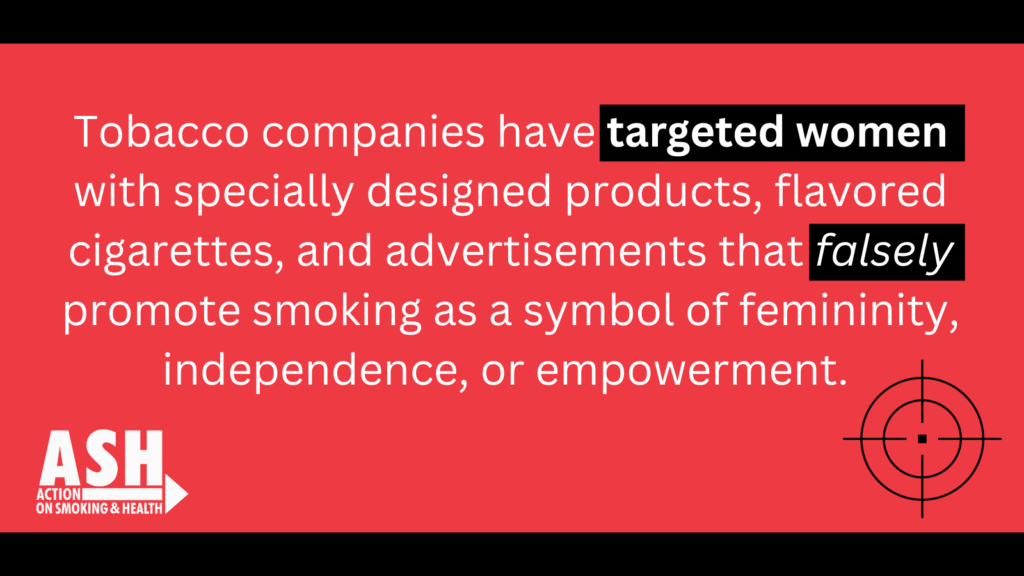Author: Vela Sree, ASH Policy Intern
 In many societies, smoking has been traditionally portrayed as a male habit, leading to a lack of awareness and recognition of women as tobacco users. This social perception contributes to the stigma and social disapproval faced by women who smoke, making it more challenging for them to seek support or access cessation services. (source)
In many societies, smoking has been traditionally portrayed as a male habit, leading to a lack of awareness and recognition of women as tobacco users. This social perception contributes to the stigma and social disapproval faced by women who smoke, making it more challenging for them to seek support or access cessation services. (source)
Historically, the tobacco industry has capitalized on societal shifts in women’s roles. In the 1920s, cigarettes became associated with women’s liberation, and by the 1930s, smoking was seen as a symbol of independence and glamor for American women. This marketing strategy continues to evolve, as exemplified by Phillip Morris’ successful launch of Virginia Slims in the 1960s, the first brand exclusively targeted to women in the United States. (source)
Using the same themes in their advertising as in previous years, the tobacco industry continues to target women today. The two primary cigarette brands promoted to women today are female brands and dual sex brands. Female brands are promoted to women specifically utilizing feminine imagery, such as Virginia Slims, Capri, Misty, and the Camel No. 9 brand by R.J. Reynolds. Brands that cater to both sexes, like Marlboro, market to women using images of independence and enjoyment. (source)
Tobacco companies have targeted women with specially designed products, flavored cigarettes, and advertisements that falsely promote smoking as a symbol of femininity, independence, or empowerment. Additionally, the tobacco industry markets to women that smoking can help regulate weight as well as control negative moods and stress. These strategies, when combined with the impact of media and peer pressure, increase the likelihood of initiating smoking behaviors. Among women, these tactics result in higher initiation rates than without using them. They also serve as obstacles to quitting. (source)
Globally, approximately 10% of women smoke tobacco, compared to 34% of men. However, it is important to note that these figures vary significantly across countries and regions. Smoking is less common among women in several high-income nations, such the United States and Canada, where the rate is around 15%. On the other hand, in low- and middle-income nations, where the majority of the world’s 1.3 billion tobacco users reside, the prevalence of smoking is much higher, exceeding 80% of people. (source)
High-income countries have lower rates of smoking among women due to factors such as awareness and education campaigns, access to healthcare resources, stricter tobacco control policies, changing social norms, and higher costs of tobacco products. These factors collectively contribute to a reduced prevalence of smoking in high-income countries compared to low-income countries. (source)
Women with a lower socioeconomic status, particularly women of color, experience higher smoking rates compared to their counterparts with a higher income due to a combination of factors that influence tobacco use within disadvantaged communities. Portrayals of smoking in films do not reflect the socioeconomic reality of most smokers: smokers in films are rich or successful, which is the reverse of reality. (source)
Targeted marketing and advertising by tobacco companies disproportionately impact neighborhoods with lower-income levels and communities of color. Tobacco companies target these neighborhoods with more cigarette advertising: larger signs, and three times as many brand ads. (source)
Additionally, tobacco manufacturers strategically exploit the socioeconomic challenges faced by individuals in poverty, such as stress, limited resources, and sometimes hopelessness, to foster reliance on cigarettes as a false coping mechanism. Moreover, the affordability of cigarettes plays a significant role. Tobacco companies lobby to keep tobacco taxes lower and offer coupons, so they can strategically sell cheaper cigarettes in communities with lower incomes, making them more accessible and affordable for individuals facing financial constraints. (source)
Unfortunately, women often face barriers with limited health care services and limited access to smoking cessation resources, particularly due to financial constraints, lack of insurance coverage, and limited availability of gender-specific and culturally specific cessation programs. (source)
Women of color face unique challenges related to tobacco use. According to the CDC, smoking prevalence among American Indian/Alaska Native women is approximately 23%, followed by non-Hispanic white women at 17%. In the U.S., African American women have a smoking prevalence of around 14%, while Hispanic and Asian women have rates of approximately 8% and 5%, respectively. Targeted marketing by the tobacco industry and cultural factors can influence smoking behaviors within different communities. (source)
Bridging the gender gap in tobacco control is essential for comprehensive policies and to promote gender equity in public health. Recognizing and addressing the unique challenges faced by women in relation to tobacco use empowers them to lead tobacco-free lives. Through concerted efforts, including targeted interventions, awareness campaigns, and gender-specific cessation programs, we can achieve this goal.
This starts by raising awareness about the significant health risks women face due to smoking. We must then expose and challenge the industry’s deliberate targeting tactics aimed at women. It is crucial to reject any attempts to link smoking, a harmful habit, with women’s rights and societal progress. By taking these decisive steps, we can protect women’s health and undermine the harmful impact of the tobacco industry on their well-being. (source)









